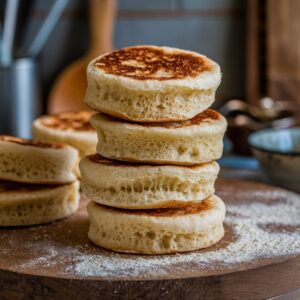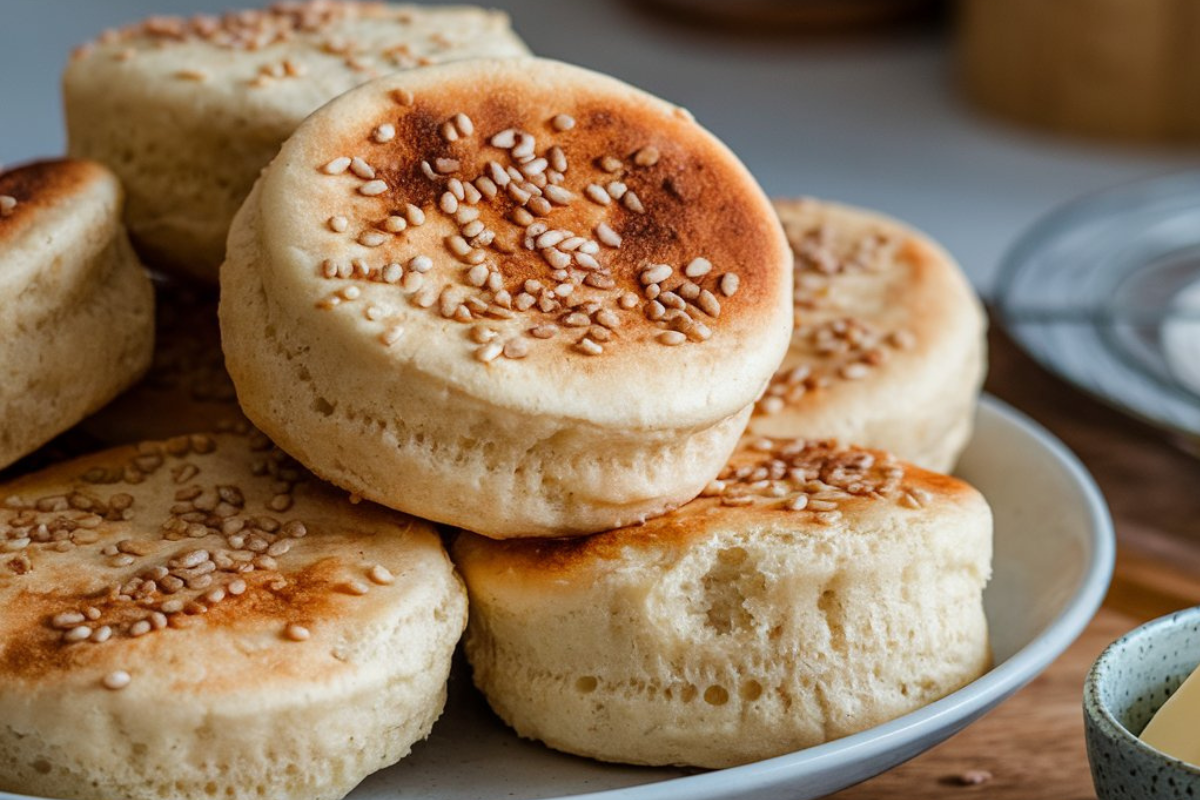When it comes to breakfast staples, few things compare to the soft, chewy texture of a perfectly cooked English muffin. But if you’re looking to elevate this humble bread to new heights, it’s time to explore the world of sourdough English muffins. These delightful muffins combine the tangy, fermented flavor of sourdough with the classic airy texture of a traditional English muffin. In this comprehensive guide, we’ll walk you through everything you need to know to create the ultimate homemade sourdough English muffins.
From the science behind sourdough fermentation to the essential tools and techniques required, this article is your one-stop resource. By the end, you’ll have all the knowledge you need to bake these versatile muffins in your own kitchen, bringing a healthy, flavorful twist to your breakfast table.
Why Choose Sourdough English Muffins?
If you’re wondering why sourdough is worth the extra time and effort, let’s break it down:
- Enhanced Flavor: Thanks to the fermentation process, sourdough English muffins have a deeper, more complex flavor than those made with commercial yeast. The natural bacteria in the sourdough starter produce lactic acid, giving the muffins a subtle tanginess.
- Healthier Digestion: Sourdough is easier on your digestive system because the fermentation breaks down gluten and other hard-to-digest proteins. Many people who are sensitive to gluten find that they can tolerate sourdough products more easily.
- Longer Shelf Life: The acidity in sourdough acts as a natural preservative, meaning your muffins will stay fresher for longer without the need for preservatives.
The Unique Texture of Sourdough English Muffins
While traditional English muffins are known for their characteristic nooks and crannies, which are perfect for trapping butter and jam, sourdough English muffins offer an additional layer of complexity. The fermentation process creates a light, airy crumb on the inside, while the outside remains slightly crisp after griddling.
If you’re already intrigued by the benefits of sourdough and want to explore its uses in other dishes, consider making sourdough French toast, another breakfast classic elevated by sourdough.
Essential Ingredients and Equipment for Making Sourdough English Muffins

Before diving into the recipe, you’ll need to gather a few key ingredients and tools:
Ingredients
- Sourdough Starter: The key ingredient in any sourdough recipe is the starter. Make sure it’s active and bubbly before use. If you’re unfamiliar with starters, don’t worry—we’ll cover how to make and maintain one in this guide.
- Bread Flour: While you can use all-purpose flour, bread flour is ideal for achieving a chewy texture and better gluten development.
- Warm Water: Essential for activating the starter and ensuring smooth dough consistency.
- Salt: A pinch of salt enhances the flavor.
- Honey or Sugar (optional): You can add a touch of sweetness to the dough, though this is entirely optional.
- Butter or Oil: Used to grease the skillet or griddle for cooking the muffins.
Tools You’ll Need
- Mixing Bowls: A large mixing bowl is required for combining the ingredients.
- Dough Scraper: This tool helps in handling and shaping the sticky sourdough dough.
- Griddle or Cast Iron Skillet: The muffins are cooked on the stovetop, so a sturdy, well-heated surface is necessary.
- Round Cookie Cutter: For shaping the muffins uniformly.
Preparing Your Sourdough Starter
The backbone of any good sourdough recipe is a healthy, active starter. If you don’t already have one, it’s easy to make your own by combining equal parts water and flour, allowing natural yeast and bacteria from the environment to colonize the mixture.
Here’s a quick starter guide:
- Day 1: Mix 100g of flour (preferably whole wheat or rye) with 100g of water in a clean jar. Cover loosely and leave at room temperature.
- Day 2–7: Every 24 hours, discard half the mixture and feed it with 100g of flour and 100g of water. By day 5–7, your starter should be bubbly and active, ready for baking.
For more detailed guidance on starting and maintaining a sourdough starter, check out this sourdough starter guide.
Step-by-Step Recipe for Making Sourdough English Muffins.
Now that you have your starter ready, it’s time to make the muffins.
Step 1: Mix the Dough
In a large bowl, combine 100g of active sourdough starter, 250g of bread flour, 150g of warm water, and 6g of salt. Optionally, you can add 1 tablespoon of honey or sugar for a touch of sweetness. Mix the ingredients until they form a sticky dough.
Cover the bowl with plastic wrap or a damp kitchen towel, and let the dough rest for 30 minutes. This resting period allows the flour to fully hydrate and makes the dough easier to work with.
Step 2: Perform Stretch and Folds
After the initial rest, perform three to four rounds of stretch and folds. To do this, pull one corner of the dough up and fold it over the center. Rotate the bowl and repeat on all sides. This helps develop gluten strength without the need for extensive kneading.
Cover the bowl again and let it sit at room temperature for 4–6 hours, or until the dough has doubled in size.
Step 3: Shape the Muffins
Once the dough has fermented and risen, turn it out onto a lightly floured surface. Roll it out to a thickness of about 1 inch. Use a round cookie cutter or an inverted glass to cut out muffin rounds.
Transfer the rounds to a parchment-lined baking sheet and dust them lightly with flour or cornmeal. Cover and let them rise for another 1–2 hours.
Step 4: Cook the Muffins
Preheat your griddle or skillet over medium-low heat and lightly grease it with butter or oil. Carefully transfer the muffin rounds to the griddle, cooking each side for 5–7 minutes or until they’re golden brown and have risen slightly.
You’ll know the muffins are done when they sound hollow when tapped. Let them cool slightly before slicing into them to reveal the characteristic nooks and crannies.
Troubleshooting Common Sourdough English Muffin Problems.
Even seasoned bakers can run into issues when making sourdough for the first time. Here are a few common problems and how to fix them:
- Flat Muffins: This usually happens when the dough hasn’t risen enough during the second proof. Make sure the dough has nearly doubled in size before cooking.
- Dense or Chewy Texture: If your muffins are too dense, it could be due to under-fermentation. Let the dough rise longer, and ensure your starter is active and bubbly.
- Burned Exterior, Raw Interior: If the outside of your muffins is browning too quickly, lower the heat on your skillet or griddle. You want a steady, moderate heat to cook them evenly throughout.
Creative Variations on Sourdough English Muffins.
Once you’ve mastered the basic recipe, there’s plenty of room for creativity! Here are some fun variations to try:
1. Cheese and Herb Sourdough English Muffins
For a savory twist, add shredded cheddar cheese and a sprinkle of herbs like rosemary or thyme to the dough before shaping. These muffins are perfect for making breakfast sandwiches or serving alongside soups and stews.
2. Cinnamon Raisin Sourdough English Muffins
For a sweet option, mix in cinnamon and raisins to the dough. These muffins are a delicious treat when toasted and topped with butter and honey.
3. Whole Wheat Sourdough English Muffins
For a healthier option, substitute half of the bread flour with whole wheat flour. You may need to adjust the hydration levels slightly, as whole wheat flour absorbs more water.
Storing and Freezing Sourdough English Muffins.
One of the best things about sourdough English muffins is that they store beautifully. Here’s how to keep them fresh:
Room Temperature
Store the muffins in an airtight container at room temperature for up to 3 days. Make sure they are fully cooled before storing to prevent condensation.
Freezing
For longer storage, freeze the muffins. Place them in a single layer on a baking sheet and freeze until solid. Then, transfer them to a zip-top bag or airtight container. They’ll last up to 3 months in the freezer. When you’re ready to eat, simply pop them in the toaster or reheat in the oven.
How to Use Sourdough English Muffins in Meals.
These versatile muffins aren’t just for breakfast. Here are some creative ways to enjoy them throughout the day:
- Egg Sandwiches: Layer scrambled eggs, cheese, and bacon or avocado between two muffin halves for a hearty breakfast sandwich.
- Mini Pizzas: Use the muffins as the base for mini pizzas. Top with marinara sauce, mozzarella, and your favorite toppings before broiling until bubbly and golden.
- Burger Buns: Sourdough English muffins make excellent substitutes for traditional burger buns, adding a unique flavor to your burgers.
- Toast with Toppings: Keep it simple by toasting the muffins and adding your favorite toppings like butter, jam, or avocado.
FAQs.
How long do sourdough English muffins last?
Stored at room temperature, they last for 3–5 days. When frozen, they’ll keep for up to 3 months.
Can I use all-purpose flour instead of bread flour?
Yes! While bread flour provides better structure, all-purpose flour will work as well. Just be prepared for a slightly different texture.
How do I make my muffins softer or crispier?
For softer muffins, add a bit more water to the dough and be careful not to overcook them. If you prefer a crispier exterior, cook them slightly longer on the griddle or toast them before serving.
Can sourdough English muffins be made vegan?
Absolutely! You can replace honey with maple syrup or sugar, and substitute butter with coconut oil or margarine to make the recipe fully vegan.
Conclusion
Making your own sourdough English muffins at home may take a bit of time and patience, but the results are well worth it. The tangy flavor, soft interior, and crispy exterior make these muffins a versatile addition to any meal. Whether you’re a seasoned baker or just starting out, this guide provides everything you need to create the perfect sourdough English muffins. Happy baking!

